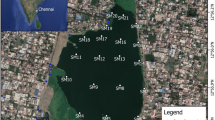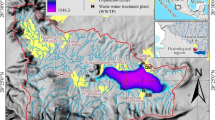Abstract
Lake George is a shallow equatorial lake in Uganda which, around its fringe, has a wetland designated as a Ramsar site of high international importance. A nearby copper mine has caused serious metal pollution of the surrounding land. Results show that heavy metals from mine waste, particularly copper and cobalt, are entering Kahendero Swamp, part of the Ramsar wetland, and contaminating the lake. In the lake, metals pass along the food chain. The distribution of metals in the wetland and possible modes of transport into the lake are discussed. The consequences of the metal contamination are considered and recommendations for its clean-up, especially in the light of future developments, are made.
Similar content being viewed by others
References
Bugenyi, W. B., 1979. Copper ion distribution in the surface waters of Lakes George and Idd Amin. Hydrobiologia 64: 9–15.
Cooper, P. F. & B. C. Findlater (eds), 1990. Constructed wetlands in water pollution control. Pergamon Press, Oxford, 605 pp.
Dallinger, R., F. Prosi, H. Segner & H. Back, 1987. Contaminated food and uptake of heavy metals by fish: A review and a proposal for further research. Oecologia 73: 91–98.
Denny, P., 1985. Submerged and floating-leaved aquatic macrophytes (euhydrophytes). In: P. Denny (ed.), The Ecology and Management of African Wetland Vegetation. Dr W. Junk Publishers, The Hague: 19–42.
Denny, P., 1989. Wetlands. In: Strategic Resources Planning in Uganda. UNEP Report IX. 103 pp.
Denny, P., 1992. African Wetlands. In Finlayson & M. Moser (eds), Wetlands. IWRB, Slimbridge: 115–148.
Denny, P., 1993. Wetlands of Africa: Introduction. In D. F. Whigham, D. Dykyjova & S. Hejny (eds) Wetlands of the World. Kluwer Academic Publishers, Dordrecht, The Netherlands: 1–31.
Denny, P. & F. Turyatunga, 1992. Uganda wetlands and their management. In E. Maltby, P. Dugan & J. C. Lefeuvre, (eds), Conservation and Development: The Sustainable Use of Wetland Resources. Proceedings of the Third International wetlands Conference, Rennes, France, 19th-23rd September 1988. IUCN Gland, Switzerland: 77–84.
Denny, P. & P. Welsh, 1979. Lead accumulation in plankton blooms from Ullswater, the English Lake District. Envir. Pollut. 18: 1–9.
Driver, P. & E. Tukahirwa (eds), 1990. Preliminary Environmental Impact Assessment of Kasese Cobalt Plant Stockpiles, Western Uganda. IUCN Report, 41 pp.
Dunn, I. G., M. J. Burgis, G. G. Ganf, L. M. McGowan & A. B. Viner, 1969. Lake George, Uganda: A limnological survey. Int. Ver. Theor. Angewand. Limnol., 17: 284–288.
Edroma, E. L., 1974. Copper pollution in Rwenzori National Park, Uganda. J. appl. Ecol. 11: 1043–1056.
El-Domiaty, N. A., 1987. Stress response of juvenile Clarias lazera elicited by copper. Comparat. Biochem. Physiol. 88C: 259–262.
Everard, M. & P. Denny, 1985. Particulates and the cycling of lead in Ullswater, Cumbria. Freshwat. Biol. 15: 215–226.
Forstner, U. & G. T. W. Wittmann, 1981. Metal Pollution in the Aquatic Environment. Springer-Verlag, Berlin, 486 pp.
Ganf, G. G., 1974a. Phytoplankton biomass and distribution in a shallow eutrophic lake (Lake George, Uganda). Oecologia 16: 9–29.
Ganf, G. G., 1974b. Diurnal mixing and the vertical distribution of phytoplankton in a shallow equatorial lake (Lake George, Uganda). J. Ecol. 62: 611–629.
Guntenspergen, G. R., F. Stearns & J. A. Kadlec, 1990. Wetland Vegetation. In: Hammer, D. A. (ed.), Constructed wetlands for wasterwater treatment. Lewis Publishers Inc. Michigan: 72–88.
Hammer, D. A., (ed.), 1990. Constructed wetlands for wastewater treatment. Lewis Publishers Inc. Michigan, 831 pp.
Lan, C., G. Chen, L. Li & M. H. Wong, 1990. Purification of wastewater from a Pb/Zn mine using hydrophytes. In Cooper, P. F. & B. C. Findlater (eds), Constructed wetlands in water pollution control. Pergamon Press, Oxford: 419–427.
Lock, J. M., 1973. The aquatic vegetation of Lake George, Uganda. Phytocoenologia 1: 250–262.
Mbeiza, N., 1993. Impact of the copper mining complex on the soils and some flora of Kahendero swamp, Lake George, Western Uganda. Unpublished MSc Thesis, Makerere University, Kampala, Uganda.
Mckim, J. M. & D. A. Benoit, 1971. Effects of long-term exposures to copper on survival, growth and reproduction of brook trout (Salvelinus fontinalis). J. Fish. Res. Bd Can., 28: 655–662.
Pomeroy, D., 1990. The Lake George Wetlands. IWRB Workshop on Waterflow and Wetland Management March 1990. Makerere University Institute of Environment and Natural Resources, 16 pp.
Radhakrishnaiah, K., 1988. Accumulation of copper in the organs of freshwater fish, Labeo rohita (Hamilton) on exposure to lethal and sunlethal concentrations of copper. J. envir. Biol. 9: 319–326.
Salomons W. & U. Forstner, 1984. Metals in the Hydrocycle. Springer-Verlag, Berlin. 349 pp.
Silver, M., 1990. Control of acid mine drainage including coal pile and ash pond seepage. (a) Biology and chemistry of generation, prevention and abatement of acid mine drainage. In Hammer, D. A. (ed.), 1990. Constructed wetlands for wastewater treatment. Lewis Publishers Inc. Michigan: 753–760.
Talling, J. F., 1992. Environmental regulation in African shallow lakes and wetlands. Rev. d'Hydrobiol. Trop. 25: 87–144.
Talling, J. F. & I. B. Talling, 1965. The chemical composition of African lake waters. Int. Rev. ges. Hydrobiol. Hydrogr. 50: 421–463.
UNCED, 1992. The United Nations Conference on Environment and Development. Convention on Biological Diversity. Rio de Janeiro, June 1992.
Viner, A. B., 1969. The chemistry of the water of Lake George, Uganda. Int. Ver. Theor. Angewand. Limnol. 17: 289–296.
Welsh, P. & P. Denny, 1980. The uptake of lead and copper by submerged aquatic macrophytes in two English lakes. J. Ecol. 68: 443–355.
Zhang, T., J. B. Ellis, D. M. Revitt & R. B. E. Shutes, 1990. Metal uptake and associated pollution control by Typhalatifolia in urban wetlands. In Cooper, P. F. & B. C. Findlater, (eds), Constructed wetlands in water pollution control. Pergamon Press, Oxford: 451–459.
Author information
Authors and Affiliations
Rights and permissions
About this article
Cite this article
Denny, P., Bailey, R., Tukahirwa, E. et al. Heavy metal contamination of Lake George (Uganda) and its wetlands. Hydrobiologia 297, 229–239 (1995). https://doi.org/10.1007/BF00019287
Received:
Accepted:
Issue Date:
DOI: https://doi.org/10.1007/BF00019287




